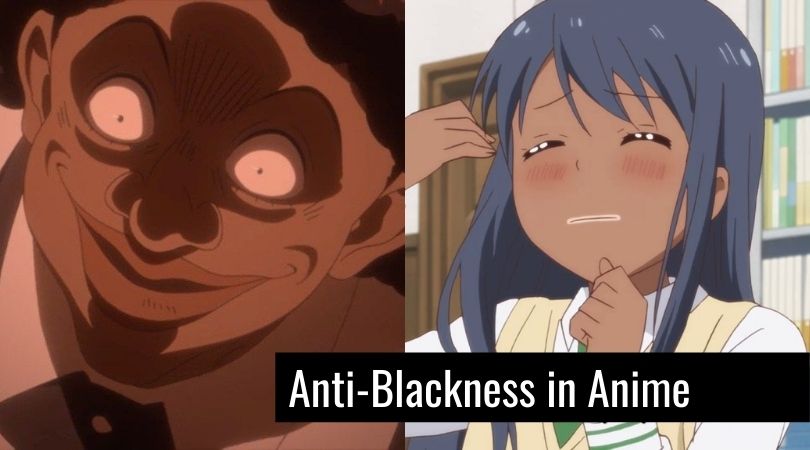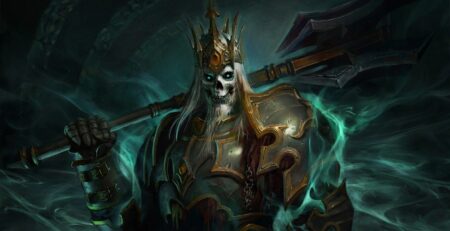
Anti-blackness is one of the root causes of most oppression and racism in the United States, but it is not just an American problem. Anti-Blackness is everywhere. It exists in one way or another across the globe. It is ingrained in many parts of society and culture, from education and media to politics and entertainment. So, it is no surprise that anti-blackness exist in anime.
The term anti-black, simply put, means to be opposed to or hostile toward Black people. Race equality think tank Runnymede Trust also defines it as “the specific exclusion and prejudice against people visibly, or perceived to be, of African descent. What most commonly refer to as Black people. Additionally, non-Black people with darker skin, such as Latinx, Indians, and Filipinos, also face forms of racism rooted in anti-blackness. There’s also colorism, a type of discrimination in which lighter skin is privileged over darker skin, among people of the same race or ethnicity. Non-Black communities have negative stereotypes about Black people, and these communities will distance themselves to maintain some level of power or privilege as they position themselves closer to whiteness.
Anime, as I mentioned, is no stranger to any of these things either. Anime has a long and, unfortunately, on-going history with anti-blackness. Frankly, a very likely reason for that is racism and prejudice formed through the earlier portrayals of Black people in American media. American media representations of Black people were not always seen in a positive light and propagated misconstrued, and racist images meant to represent Black people at that time.
It is possible the first representation that Japanese audiences saw of Black people was through these racists and stereotypical portrayals. And while it has been well over 70 years since those depictions, they still contributed to the negative attitudes towards Black people. Which in turn, is why there are many offensive and problematic portrayals of them in anime.
While I love seeing Black characters in anime, I hate it when a show will use stereotypes and or character designs that are reminiscent of racist caricatures. It reduces the characters to be the butt of a terrible hateful joke and takes away the representation that they could have been. It sucks when the industry you have invested time, money, and love in, just like any other fan, doesn’t always love you back. It hurts when creators and studios in the industry choose to depict Black people in such a disgustingly racist way.
One of the most glaring examples of this is Sister Krone from The Promised Neverland. Sister Krone’s design is inundated with racist implications, calling to mind black Americans’ image popularized by minstrel shows. This is something a lot of people don’t like to hear, but it’s objectively true. A mere side-by-side of Sister Krone and, say, an old drawing of Aunt Jemima will confirm this to be the case: the massive lips, huge nose, stronger musculature, and general servant-like aesthetic all contribute to an image of that oh-so-pernicious depiction of black women, one that has not entirely faded from cultural consciousness.
Sadly, the racist depiction of Sister Krone is not a rare occurrence in recent anime. Other relatively recent examples of anti-blackness and racist depictions in anime include Love Lab and Terraformers.In Love Lab, a school-aged girl who does full blackface acts like a soul singer because she wanted to experience Black. In the same episode, another character mentions how their older brothers fetishize Black women.
While in Terraformers, a sci-fi anime about a space crew terraforming Mars. When they arrive, they get attacked by giant mutated humanoid cockroaches called ‘Terraformars’. The TerraformArs are purposefully designed with stereotypical Black features, some of which are very reminiscent of racist caricatures.
I could go on and list more examples, but I think you get my point. Anti-blackness exists in anime. It has been a part of its past and, unfortunately, continues to exist to this day. And with so much anti-blackness in anime, it is a wonder sometimes how I can enjoy and consume content from an industry that still participates in the use of racism and stereotypes. Well, for one thing, not all anime are racist or relies on racist stereotypes for Black and other non-Japanese characters. Furthermore, I refuse to let the poor and disgusting racist choices of some creators and studios in the industry make me hate a medium that I love.
Personally speaking, as a Black woman in America, I am always aware that I live in a world where certain parts of society see me as an “other”. Viewing me as someone that exists outside of what they deem is the norm. That I am not automatically seen as a person who deserves the same rights, respect, and privileges as others. So, I am not usually surprised or shocked when I see that something is anti-black. I am disgusted and angry, but sadly I’m not shocked because I have always been aware that I live in a world that doesn’t always see me or treat me with the respect that I deserve as a person. That being said, I can enjoy, appreciate and consume anime while also not making excuses for its part in anti-blackness. I deserve to enjoy anime, too, just like any other fan. Black people deserve representation without stereotypes and racists jokes because that is the bare minimum.
Additionally, anime has a special place in Black culture. Personally, a Black anime fan, what I love about it the most is that it inspires me. Sometimes I can even find relatability in some characters and themes. For example, many of my favorite anime features characters who face impossible challenges they have to overcome or face prejudice and doubt from others around them. Nonetheless, they don’t give up. Either through hope, love, friendship, or inner strength, they persevere to achieve their goals. So I can see why that resonates with me, and maybe others, so strongly.
So then what do we do about anti-blackness in anime? How can I love and enjoy a medium that clearly doesn’t always show me the same love back?
Well, for one, as I said before, anti-blackness is everywhere. But just because I can’t escape it does not mean I have to tolerate it. Ignoring anti-blackness by never watching any anime ever again won’t put an end to anti-blackness. To be clear, I’m not saying to continue to consume specific work that is repeatedly racist or anti-black. I am saying you should also speak out and let the creators and other fans know that their work is problematic. You, me, and any other fans of anime have the right to share our critiques and opinions, and the artists should listen to them.
I love seeing Black characters in anime because I love seeing characters that look like me in the things I love. However, that reflection should not come at the cost of being made the butt of racist and anti-black jokes. It is sad to say that even in 2021, we need to call out anti-blackness in pop culture, but if we don’t then, it will continue to exist.
We have to demand better and set a standard for how Black people should be represented respectfully because, frankly, we deserve better. There is no excuse for anti-blackness or racist themes to exist in anime or any medium for that matter. We have to demand better and set a standard for how Black people should be represented respectfully.

Thankfully there have been anime creators in the industry over the years who put in the work and effort to make their series diverse and do not use racist caricatures or stereotypes for their characters. One in particular that comes to mind is Shinichirō Watanabe. Watanabe. is a Japanese anime television and film director who is best known for directing widely popular series such as Cowboy Bebop, Samurai Champloo, Carole & Tuesday, and Space Dandy. Watanabe is also well known for making anime that represents a racially diverse world.
During an interview following the conclusion of Cowboy Bebop Watanabe had this today about diversity in anime. “I paid a lot of attention to skin color. Also to using multiple languages. Lots of times when you watch anime, the characters all have white skin — all the characters in fantasy stories all have white skin, which I never liked. I wanted to have lots of characters in Bebop without the white skin, and if people weren’t used to that, well, maybe it would even make them think a little bit about it”. I’m grateful to creators like Watanabe who have worked to make anime more racially diverse and inclusive. It was anime like Cowboy Bebop that first showed me that Black people can exist in anime.
Now there are more creators in the industry who are doing the real work to represent Black characters in anime better. This is done by broadening the spectrum of skin tones, and putting in more effort when it comes to illustrating features like hair texture, lips, and palms of hands. Some great examples of this include Black characters being more respectfully and accurately designed, such as Ogun Montgomery from Fire Force and Aran Ojiro in Haikyuu. Another preseason these characters’ representation is important is because they are Black characters living and existing in their show’s version of Japan. They an example of how Black people and other races can be included in anime.
Other examples of improvement are anime series with Black-lead characters like Carole & Tuesday and Cannon Busters. There is also more Black and BIPOC (Black, Indigenous, and People of Color) representation behind the animation, like voice talents Zeno Robinson and Anairis Quiñones who voice various characters in anime series. And now there’s even D’Art Shtajio, a Black-owned anime studio located in Tokyo, Japan, founded by twin brothers Arthell Isom and Darnell Isom.
It means a lot as an anime fan that these creators are putting in the effort to give proper representation to Black characters. Their work helps to set a new standard for how Black characters deserve to be represented in anime. So, while the anime industry does have its issues and problematic past with anti-blackness, there is hope for more improvement to come as more creators put in the work and intentional in portraying Black characters. I have hope that as time goes on, the industry I love so much will love me back the same



